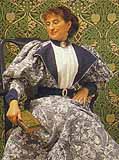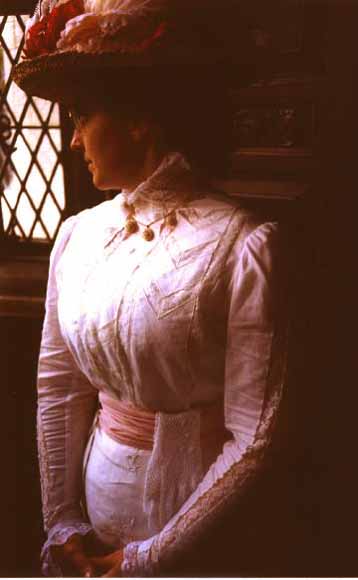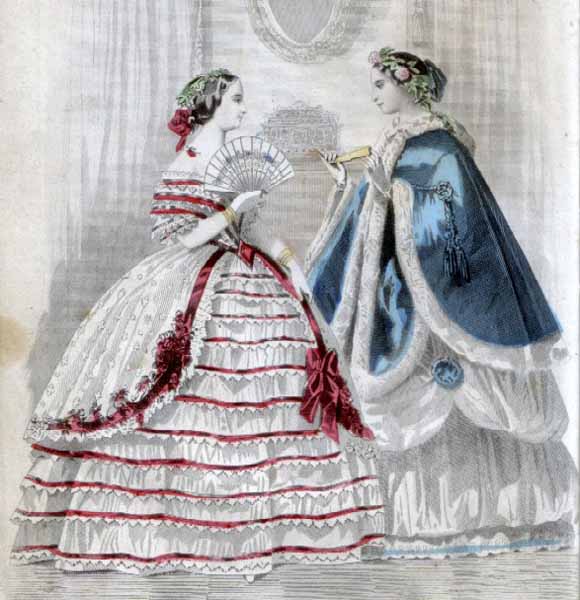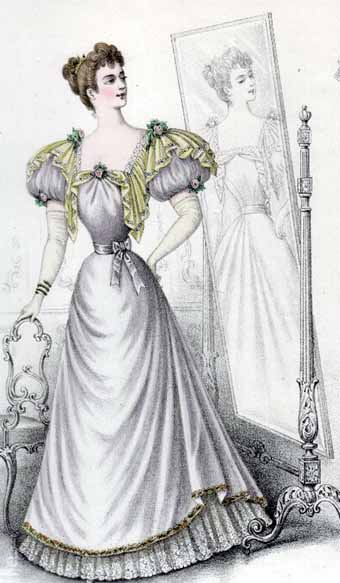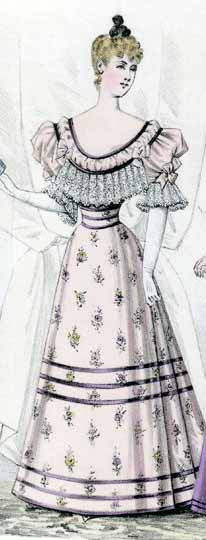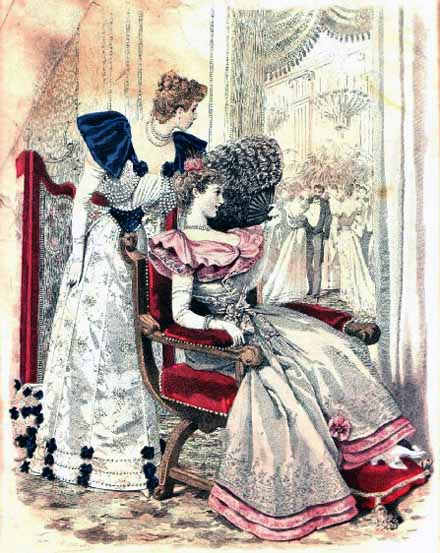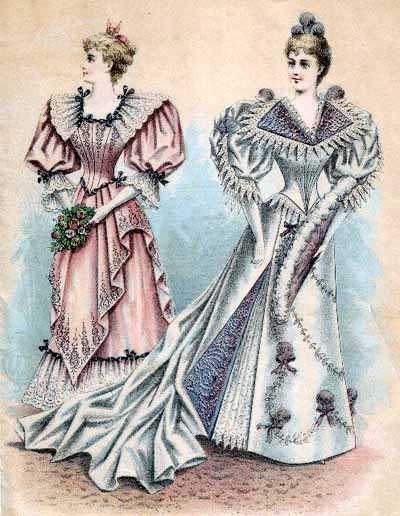
Fashion Plates of the 1890s:
Evening Dress
|
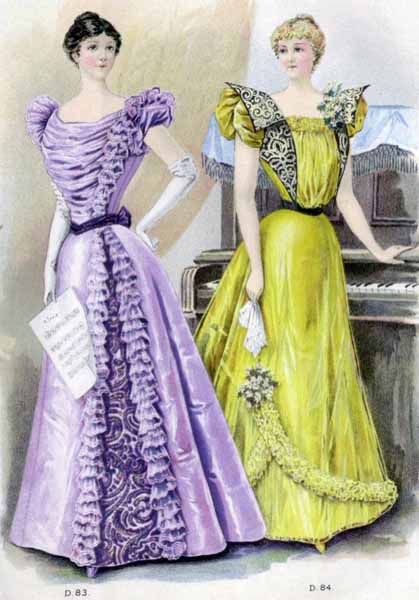
|
Table of Contents:
- Color Fashion Plates
- Evening Toilette, 1893
- Ball Toilette, 1893
- Paris Dinner Gown, 1894
- Paris Opera Toilette
- Paris Dinner Gown, 1894
- Newport Toilettes: Dinner and Dancing Dresses, 1894
- Paris Dinner Gown, 1894
- Dinner Toilettes, 1895
- Ball Dresses, 1896
- Ladies’ Evening Waist, 1896
- Both Stylish and Economical:
Summer Evening Gowns, 1897
- Evening Toilettes, 1897
- Full Dress Toilettes, 1898
- Princess Line Dinner Gown, 1899
Related Pages:
|
Miscellaneous colored fashion plates
no descriptions available (click on picture for larger view)
Contemporary Descriptions of ladies’ Evening Dress
arranged chronologically
Evening Toilette.
 Nile-Green silk with handsome embroidery is the material of the evening gown
illustrated. The round corsage without darts is trimmed around the low neck with three strands of beads of green and golden brown
shades. Below this is a drapery of silk embroidered with white silk and smaller beads. Rows of beads like those at the top are around
the waist, and triple rows of beads fall thence on the skirt. The skirt is edged at the foot with a row of beads, and is very richly
embroidered all around in points done with white silk and beads. The point in the middle of the front is higher than the others, and
each point is bordered with a row of beads. The fan is of white ostrich feathers on shell sticks. Long white suede gloves complete the
toilette.
Nile-Green silk with handsome embroidery is the material of the evening gown
illustrated. The round corsage without darts is trimmed around the low neck with three strands of beads of green and golden brown
shades. Below this is a drapery of silk embroidered with white silk and smaller beads. Rows of beads like those at the top are around
the waist, and triple rows of beads fall thence on the skirt. The skirt is edged at the foot with a row of beads, and is very richly
embroidered all around in points done with white silk and beads. The point in the middle of the front is higher than the others, and
each point is bordered with a row of beads. The fan is of white ostrich feathers on shell sticks. Long white suede gloves complete the
toilette.
December 1893, Harper’s Bazar.
|
Top
Ball-Toilette
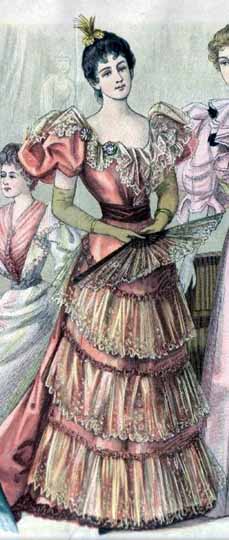 Low-cut Ball-toilette of Atlas for a young lady. Three rounded lace ruffles on the front of the skirt.
Lace berthe with rosettes of brilliants.
Low-cut Ball-toilette of Atlas for a young lady. Three rounded lace ruffles on the front of the skirt.
Lace berthe with rosettes of brilliants.
Illustrirte Frauen-Zeitung,
1 December 1893
The lace ruffles on this dress are probably fine, lightweight, net lace embroidered or with hand made bobbin
lace appliqué. The ruffles are edged with ruched ribbon or silk, perhaps velvet, the sash also appears to be velvet. The
lace at the neckline is gathered assymetrically, looped up with rhinestone rosette ornaments. The gloves might be buff-colored; could
be either either kid or suede. She wears simple bracelets, carries a large lace fan with black sticks. Her hair is pouffed slightly
and worn with delicately curled bangs and a fairly high bun, with a headdress is a small aigrette of feathers.
The term Atlas probably refers to silk from the Atlas moth, a giant silk producing moth in Asia
|
Top
A Paris Dinner Gown.
This elegant gown for Lenten dinner parties is of royal blue velvet. The corsage is plain in front and laced
in the back. A bertha of antique lace veils the large balloon sleeves, and is draped in front with a jeweled brooch. The belt
of satin is embroidered with silk in the natural colors of the flower design, and is finished by a large band simulating a sash,
wider at the foot than at the top, and terminated in a deep fringe. A bouquet of natural flowers is at the head of the sash. The
skirt, with very slight train, falls on godet pleats. A collar of pearls and white suede gloves complete the toilette.
Harper’s Bazar, 24 February 1894
|
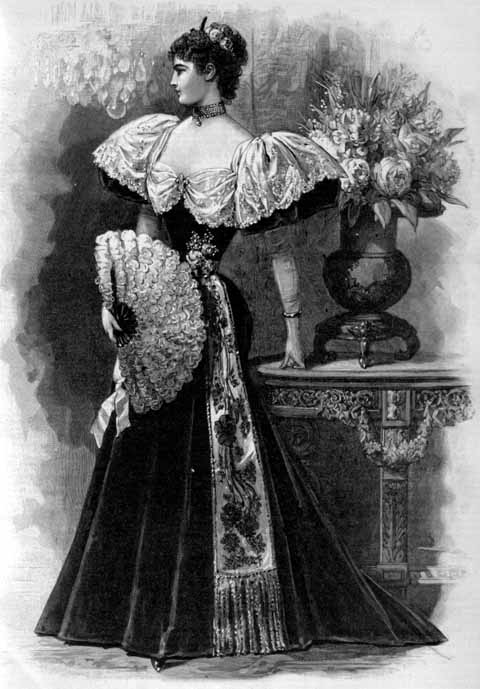
Paris Dinner Gown
Harper’s Bazar, 24 February 1894
|
Top
Paris Opera Toilette.
An evening gown of buttercup-yellow satin and dahlia-colored velvet is from Madame Buzenet of Paris.
The pointed corsage has a drapery of the dark velvet around the neck, which also forms butterfly sleeves. Below this is a bertha of the
satin cut in vandykes, and embroidered with gold and pearl beads done partly on velvet and partly on satin. The skirt has little
pleated basques falling straight on the sides, and is trimmed with vines of embroidery in gold and beads extending down each side of the
front. The foot of the skirt is cut in points, embroidered and fringed, and falling on a band of dahlia velvet. The train is draped
slightly, and is ornamented on one side with a velvet panel, and on the other with two large velvet bows.
Harper’s Bazar, 3 March 1894
|
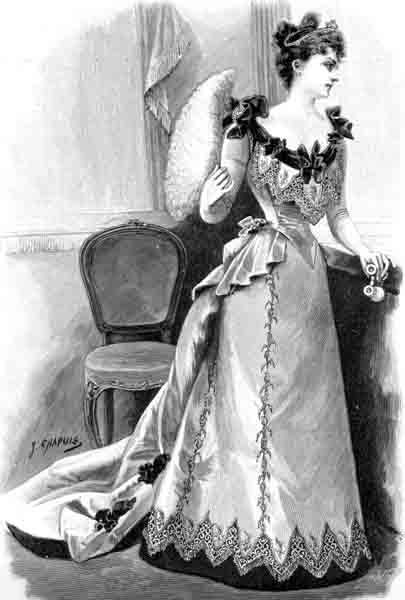
Paris Opera Toilette
Harper’s Bazar, 3 March 1894
|
Top
Paris Dinner Gown.
A charming gown for dinners and musicals is a favorite model with Mesdames Sarah Mayer et Morhauge, of Paris.
It is of cream-white tulle with dots of green velvet appliqué on a transparent light green. The corsage in the shape of a
little jacket has drooping pointed revers of velvet of a darker green shade; the sharply pointed vest, the sleeves, the
epaulettes, and the bow are of similar velvet. The corsage has pleated basques in front and is terminated in the back by two ends
falling almost to the edge of the skirt. The round skirt is trimmed around the foot with tow rows of velvet drawn in careless
folds, and held at intervals by large bows.
Harper’s Bazar, 3 March 1894
|

Paris Dinner Gown
Harper’s Bazar, 3 March 1894
Top
|
Newport Toilettes:
Dinner and Dancing Dresses
Rich and glowing colors are effective at the sea-shore, and will be found this season in many costumes carried to Newport-
most beautiful of summer cities. Evening dresses for Summer dinners and dances are of the embroidered muslins now having such
favor, and also of moiré and chiffon. White and pink are the colors most used, sometimes alone, more often together. Yellow
frocks are also made with chiffon and embroidery on moiré, in odd brocades of small designs, and on taffeta or satin. A Félix
gown of delightfully simple style is of a white moiré dotted with small stars of satin. The half-low corsage of moiré fitted
by darts and laced in the back, is lengthened to pass inside the skirt belt of chiffon. It is trimmed around the neck with
carelessly draped folds of pink chiffon, studded at intervals with single pink roses without foliage. Below this falls very
low on the front a draped ruffle of the chiffon doubled, which extends to form two lengthwise ruffles on short puffed sleeves
of the white moiré. A cluster of roses separates the pink ruffles on the sleeves. The moiré skirt of seven gored breaths lined
with taffeta just touches the floor in the back, and is bordered to match the neck with pink chiffon folds studded with roses.
To give more decided coloring an apron drapery is added of doubled chiffon falling almost to the foot in front, and graduating
shorter to the belt in back, whence it falls in a double jabot low on the back breaths. Other white dresses are of taffeta
with trellised lines of white satin. The trimming is white appliqué lace in festoons, headed by folds of white chiffon caught
at intervals with butterfly bows of mirror velvet-pink, turquoise, yellow, or Nile-green.
Some new sleeves, especially pretty for diaphanous fabrics, have outlines similar to the popular mutton-
leg sleeves. They differ, however, in being puffed lengthwise along the forearm in four or five tiny puffs, very narrow at the
wrist, then gradually widening above the elbow to the armhole.
excerpt from Harper’s Bazar,
June 30, 1894
Top
|
Paris Dinner Gown.
 Moiré and mousseline are charmingly combined in the graceful evening gown from Paris,
of which an illustration is given herewith. The trained skirt proclaims that it is
for a matron—a young chatelaine who evidently prefers to leave off her jewels when
receiving her friends. The low pointed corsage is of pale-yellow moiré antique. It
is fitted by darts and laced in the back. All the top of the waist is mousseline de
soie of the same yellow tone, drawn down from the shoulders in full folds to meet at
the bust and form a ruffle below. The sleeves are each a great puff of mousseline
trimmed with double jabots of the same, held by a large bow of black satin ribbon.
Moiré and mousseline are charmingly combined in the graceful evening gown from Paris,
of which an illustration is given herewith. The trained skirt proclaims that it is
for a matron—a young chatelaine who evidently prefers to leave off her jewels when
receiving her friends. The low pointed corsage is of pale-yellow moiré antique. It
is fitted by darts and laced in the back. All the top of the waist is mousseline de
soie of the same yellow tone, drawn down from the shoulders in full folds to meet at
the bust and form a ruffle below. The sleeves are each a great puff of mousseline
trimmed with double jabots of the same, held by a large bow of black satin ribbon.
The train is straight and not of great length. It is of the yellow moiré opening
on a tablier front of mousseline de soie gathered quite full on a foundation skirt
of yellow taffeta. A large rouche of the mousseline borders the foot of the
transparent tablier. A bow of black sating ribbon terminates the corsage in the back,
with long sash ends descending almost to the foot of the skirt.
White and Pink moiré gowns similar to this model have been designed for Newport, Lenox,
and other summer abiding-places. The ribbons used in some of these dresses were white
in preference to black. The mousseline matches the moiré in color in every instance.
Harper’s Bazar, 7 July 1894
Top
|
Dinner Toilettes.
Chiné-figured silk, with a light fuscia-red ground, is the material of one of the dinner
gowns illustrated. A narrow scarf of bronze velvet is knotted at intervals about the edge
of the skirt. The plain-fitting waist, with short puffed sleeves, has a heart-shaped
decolletage, framed on the shoulders and back by a deep velvet collar edged with spangled
 passementerie, and draped at the front in chiffon scarves coming from under the collar, and
hanging in lace-edged ends to below the waist.
passementerie, and draped at the front in chiffon scarves coming from under the collar, and
hanging in lace-edged ends to below the waist.
A sumptuous gown is of green velvet, with applied metallic embroidery associated with green
and brown shot moiré. The entire front of the skirt is of velvet, interrupted on each side
by a narrow moiré panel with spangled edge. The deep-folded back of the skirt is of the
moiré. The low-necked pointed bodice is of velvet, with drooping puffed sleeves of moiré.
Harper’s Bazar, 9 March 1895
|
Top
Ball Dresses.
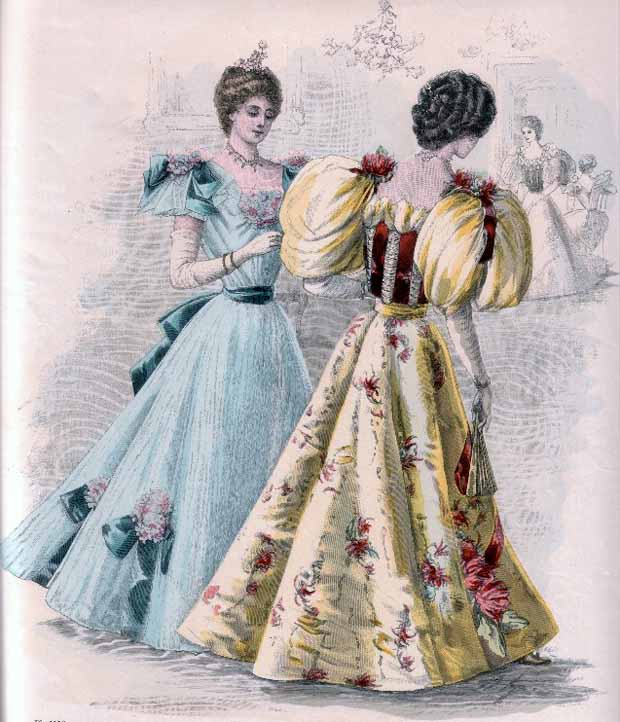 1. Creped Gauze Ball Dress with Silk Slip. Bodice of one piece of crape arranged over plain silk, cut square
in front and pointed behind. Short plain sleeves covered with pleated gauze, looped up with ribbon bows and flowers. Two bands
of ribbon at each side go from skirt hem upwards with bows and tufts of flowers. Ribbon belt with short sash.
1. Creped Gauze Ball Dress with Silk Slip. Bodice of one piece of crape arranged over plain silk, cut square
in front and pointed behind. Short plain sleeves covered with pleated gauze, looped up with ribbon bows and flowers. Two bands
of ribbon at each side go from skirt hem upwards with bows and tufts of flowers. Ribbon belt with short sash.
2. Ball dress with Crape Blouse Bodice. Fronts and back joined with beaded velvet bands. Sleeve puffs looped up
with velvet band and chrysanthemums. Rich chine silk skirt with velvet bands ending in chrysanthemum tufts, in front.
The Season, February 1896
|
Top
Ladies’ Evening Waist.
 This illustrates a ladies’ waist. The waist is exquisitely dainty in the combination of white satin and chiffon here pictured. Full
side-fronts of satin flare towards the shoulders over a full center-front of chiffon finished to form a frill heading, the neck being
low in Pompadour outline. In effect the back is a duplicate of the front. The fluffy, short sleeves are each composed of three very
full frills of chiffon mounted on a narrow fitted foundation. If preferred each sleeve may consist of one or two frills. Pearl-bead
trimming defines the edges of the side-fronts and the side-backs, and ribbon made into shoulder bows and a pretty sash gives the
finishing touch.
This illustrates a ladies’ waist. The waist is exquisitely dainty in the combination of white satin and chiffon here pictured. Full
side-fronts of satin flare towards the shoulders over a full center-front of chiffon finished to form a frill heading, the neck being
low in Pompadour outline. In effect the back is a duplicate of the front. The fluffy, short sleeves are each composed of three very
full frills of chiffon mounted on a narrow fitted foundation. If preferred each sleeve may consist of one or two frills. Pearl-bead
trimming defines the edges of the side-fronts and the side-backs, and ribbon made into shoulder bows and a pretty sash gives the
finishing touch.
The soft fullness of this mode is charming and becoming. Mousseline de soie and other tissues, embroidered or plain, are used for
evening waists, and they are worn with silken skirts.
October 1896, The Delineator.
Top
|
Both Stylish and Economical:
Summer Evening Gowns.
The question of the summer evening gown is always a perplexing one, for most women hesitate to expend large
sums upon toilettes that are certain to be exposed to the dampness that follows an August sunset; and organdies and the like,
while they are of comparatively little cost, droop too readily to be regarded with extreme favor. Much can be done with little,
however, if one be ingenious and deft. The fashion of ruffling an entire skirt is in itself a boon; and a few yards of net,
together with a skirt that did duty during the winter, can be converted into a fresh and fascinating gown. The net is not costly,
is very wide, and stand hard usage far better than do most diaphanous materials. A series of narrow ruffles edged with tiny
Valenciennes lace-black or white, as the color demands-set upon the silk foundation, will give a charming result; while a draped
bodice, made half low and unlined, mousquetaire sleeves, together with a corselet of satin, can be trusted to complete a really
striking costume at minimum cost.
Modes,
edited by May Manton,
August 1897
Top
|
EVENING TOILETTES.
Figure d 83.—This illustrates a Ladies’ costume. The pattern, which is No. 9527 and costs 1s. 8d. or 40 cents, is in ten sizes
for ladies from 30 to forty-two inches, bust measure. and is differently depicted on page 632.
The beauty of this evening toilette is well displayed in the present combination of silk and chiffon. The waist is closed at
the back, and the full, bias front, so gracefully draped in soft cross folds, is in two parts which are sewed together at the
left side in a line suggesting a Russian closing. Double frill caps fall over the puff sleeves and at the left side the upper
frill cap is extended to the bottom of the waist along the joining of the fronts. Two jabots of chiffon starting at the end
of this frill flare toward the foot of the handsome seven-gored skirt, and between the jabots the skirt is covered with an
elaborate embroidery of beads and jewels to produce the effect of a panel.
 The new styles in evening toilettes are of especial interest just now when the ball season
is opening and novel features in full dress are looked for.
The new styles in evening toilettes are of especial interest just now when the ball season
is opening and novel features in full dress are looked for.
Figure D 84.—This consists of a ladies’ waist and skirt. The waist pattern, which is No. 9484 and costs 1s. or 25 cents,
is in ten sizes for ladies from 30 to forty-two inches, bust measure, and may be seen again on page 655. The skirt pattern,
which is No. 9465 and costs 1s 3d. or 30 cents, is in seven sizes for ladies from twenty to thirty-two inches, waist measure.
A refined elegance distinguishes this evening toilette of taffeta royale and velvet, with rich Renaissance lace overlaying
the velvet revers and jacquette. Ruchings of the silk and bunches of flowers give an ornamental touch to both the waist
and skirt. The waist is fashionably known as the Senorita waist and it is closed at the center of the front. The jacquette
is a remarkably stylish adjunct and quite fanciful in shape, and between its front edges the pouch front is exceedingly
effective. The front is shirred in ruche effect at the neck and a smooth velvet belt is a decorative finish
for the bottom of the waist. The large revers flare on the shoulders and at the center of the back and stand
out stylishly on the novel sleeves, which form three handsome loop puffs.
The new circular skirt falls gracefully over a seven-gored foundation-skirt.
The varied designs, the long list of colors and the artistic materials for evening and full-dress occasions make it
possible to develop a toilette of rare loveliness and grace at reasonable cost.
December 1897, The Delineator.
Top
|
Full Dress Toilettes.
Figure 1: This consists of a ladies’ surplice pouch waist and skirt. This charming toilette
is here pictured made of flowered mousseline over silk and has a chiffon sash, flowers, and chiffon frills and ruchings for decoration.
The surplice pouch waist, fashionably known as the Alix waist, may be made without the peplum. The neck is low in V shape and is
followed by fluffy frills of the chiffon that are deepest on the shoulders and lap with the fronts in surplice style. The fronts
display the fashionable droop over the chiffon sash, which is softly knotted at the left side, the long ends being finished with deep
frills of the chiffon. Frill caps of the mousseline fall over the short puff sleeves.
The graceful circular skirt falls over a seven-gored foundation-skirt and shows the fashionable lines and flare.
Helpful hints for the development of transparent fabrics may be gained from this toilette, which is admirably adapted to gauzy
materials, grenadine, mull, organdy and the beautiful mousselines and chiffons.
Full Dress Toilettes, March 1898, The Delineator.
Top
|
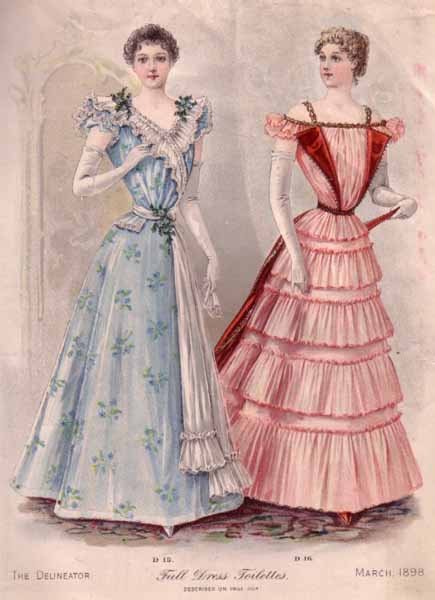
|
|
Figure 2: This consists of a ladies’ waist and skirt. Velvet and silk are here associated in this stylish toilette and
iridescent beads and passementerie provide the decoration. The Victorian waist, with its low 1830 neck and narrow shoulder-straps,
forms the most conspicuous part of this toilette, which will answer admirably for balls, receptions and dinners. The full center-front
puffs out and droops slightly between side-fronts which are rolled back in tapering revers that are bordered with iridescent beads.
Ruffle sleeves droop below the shoulders and fluff out prettily, and the waist is upheld by the shoulder straps, which are covered with
passementerie. A velvet sash surrounds the waist and ends in a bow with long ends at the back.
The six-gored skirt may be made in round length or with a sweep, and is trimmed to the belt with spaced, graduated flounces of the silk.
The toilette is commended for silk and combinations of silk and velvet, as well as for the sheer fabrics used for reception and ball
wear. bands of spangled trimming, pearl bands, lace edging and insertion are available garniture.
March 1898, The Delineator.
|
Top
Princess Line dinner gown.
 The grace and picturesqueness of the Princess gown have carried the inclinations of the fair sex by storm, and now this type of gown is
much affected by both the debutante and the matron. A captivating example of this mode is shown here developed in cactus green peau de
soie, with lace edging for the short frill sleeves, and decorated with a lace frill about the neck, heavy lace applique and pearl
trimming. The graceful lines of the figure are accentuated by the perfect adjustment of the dress, the front of which extends to the
foot at the center, while the sides and back are lengthened by a circular flounce that ripples prettily. An attractive feature of the
design is the circular ruffle, which is arranged on the front, where it induces a panel effect and outlines the circular flounce. The
dress is closed invisibly to a convenient depth at the back.
The grace and picturesqueness of the Princess gown have carried the inclinations of the fair sex by storm, and now this type of gown is
much affected by both the debutante and the matron. A captivating example of this mode is shown here developed in cactus green peau de
soie, with lace edging for the short frill sleeves, and decorated with a lace frill about the neck, heavy lace applique and pearl
trimming. The graceful lines of the figure are accentuated by the perfect adjustment of the dress, the front of which extends to the
foot at the center, while the sides and back are lengthened by a circular flounce that ripples prettily. An attractive feature of the
design is the circular ruffle, which is arranged on the front, where it induces a panel effect and outlines the circular flounce. The
dress is closed invisibly to a convenient depth at the back.
A remarkably handsome evening gown will result is a combination of plain and striped taffeta or satin associated with spangled net be
employed for the design; in this case it may be handsomely decorated with paillettes of steel or dainty jewelled passementerie.
Innumerable rich and effective combinations of materials and colors will readily suggest themselves to the tasteful modiste.
March 1899, The Delineator.
Top
|

P.O. Box 9, Nahant, Massachusetts 01908
e-mail:
phone: (781) 49-WALTZ (781-499-2589)
© 2013, Vintage Victorian, All rights reserved
|
|
|

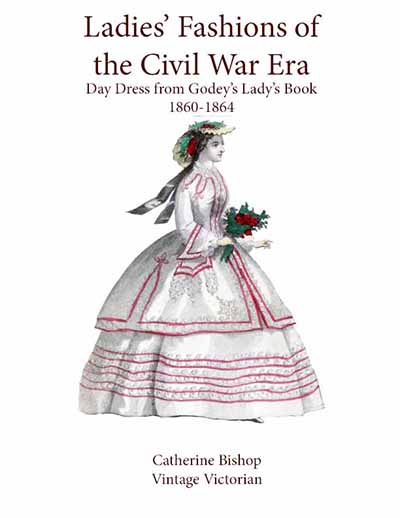



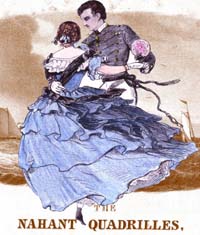
last updated 26 july 2013/csb
|
